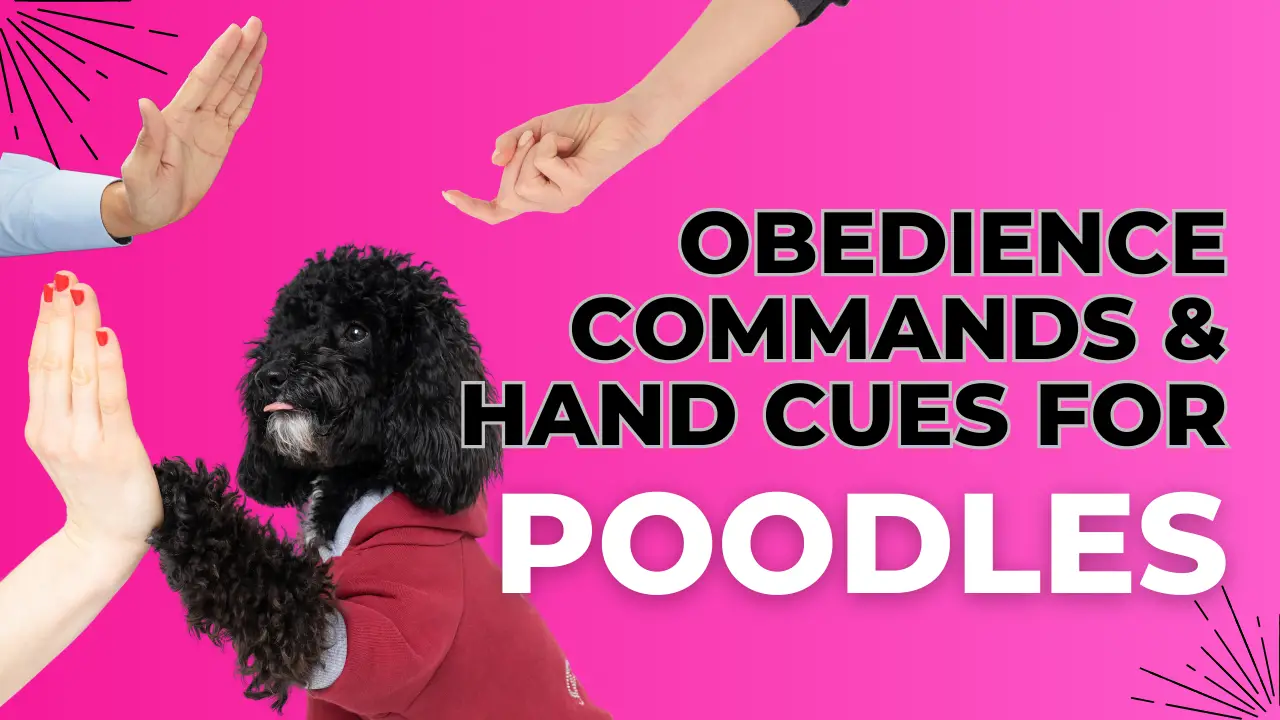Teaching your poodle obedience commands not only strengthens the bond between you and your poodle but also ensures their safety and well-being.
In this article, I will guide you through essential obedience commands and their corresponding hand cues that work wonders with poodles. Let’s dive in and discover how to communicate effectively with our poodles through these commands.

What Will You Learn? 👇
Why Teach Obedience Commands and Hand Cues?
Teaching obedience commands and hand cues to your poodle is beneficial in multiple ways. Here’s why it’s important to invest time and effort in this aspect of training:
- Safety: Obedience commands allow you to control your poodle in various situations, ensuring their safety both indoors and outdoors. They help prevent accidents and keep your poodle out of harm’s way.
- Communication: Establishing a common language through obedience commands and hand cues strengthens the communication between you and your poodle. It creates clarity and understanding, making training sessions and everyday interactions smoother.
- Behavior Management: Obedience commands provide a framework for managing your poodle’s behavior. They help redirect unwanted behaviors and encourage desired actions, leading to a well-behaved and obedient poodle.
- Bonding: Training your poodle with obedience commands and hand cues strengthens the bond between you and your furry companion. It builds trust, respect, and a deeper connection, enhancing your relationship.
Essential Obedience Commands for Poodles
1. Sit
The “sit” command is one of the foundational obedience commands that every poodle should learn. It teaches your poodle to sit on command and wait patiently. Here’s how to teach this command:

Read our Smart Poodles - Smart Tricks eBook for only $2.99
Dive into a treasure trove of engaging tricks and tips designed specifically for your poodle!
- Hold a treat close to your poodle’s nose, and slowly move your hand upwards. Your poodle’s natural response will be to follow the treat, causing them to sit.
- As soon as their bottom touches the ground, say “sit” clearly and give them the treat as a reward.
- Practice this command in different locations and gradually phase out the treat, relying solely on verbal cues and hand signals.
2. Stay
The “stay” command is crucial for keeping your poodle in one place until you give them permission to move. Here’s how to teach this command:
- Start with your poodle in a sitting position.
- Extend your open palm in front of your poodle’s face, palm facing them, and say “stay” firmly.
- Take a step backward while keeping your hand extended. If your poodle stays in place, return to them and reward them with a treat and praise.
- Gradually increase the distance and duration of the “stay” command, always rewarding your poodle for successful stays.
3. Come
The “come” command is crucial for calling your poodle to you, especially in potentially dangerous situations. Here’s how to teach this command:
- Start in a quiet and secure area with minimal distractions.
- Get down to your poodle’s level and open your arms, calling them by their name followed by “come” in an enthusiastic tone.
- If your poodle starts moving towards you, praise them and reward them with a treat.
- Gradually increase the distance between you and your poodle, practicing the “come” command in different environments.
Hand Cues for Obedience Commands
In addition to verbal cues, hand signals or hand cues can greatly enhance your poodle’s understanding of obedience commands. Here are some commonly used hand cues for essential obedience commands:
- Sit: Hold your hand up, palm facing upwards, and move it from a low position to a higher position.
- Stay: Extend your hand, palm facing your poodle, and hold it firmly.
- Come: Extend your arm outwards, with your palm facing up, and beckon your poodle towards you.
Remember to pair these hand cues with their corresponding verbal cues to reinforce your poodle’s understanding and response to the commands.
Practice Makes Perfect!
As with any training, consistency and practice are key to success. Here are some tips to make the training process more effective:
- Keep training sessions short and frequent to maintain your poodle’s focus and enthusiasm.
- Use positive reinforcement, such as treats, praise, and play, to reward your poodle for correct responses.
- Gradually increase the level of distractions during training sessions to ensure your poodle can follow commands in different environments.
- Stay patient and understanding, as each poodle learns at their own pace.
Share Your Training Journey!
I hope these insights into obedience commands and hand cues for poodles help you establish effective communication with your furry friend. Remember, training should always be a positive and enjoyable experience for both you and your poodle. If you have any questions or would like to share your training journey, please leave a comment below. Let’s create a community of poodle lovers who support and learn from each other. Happy training!
Comment below and let us know about your experiences in training your poodle with obedience commands and hand cues. We’d love to hear from you!
Marko is the founder and author at PoodleHQ, where he blends profound expertise with formal training in Animal Behavior and Canine Genetics. With multiple generations of poodles under his care, he’s a breed connoisseur, honored with the Canine Care Excellence Award and lauded by the International Pet Enthusiasts Association.

